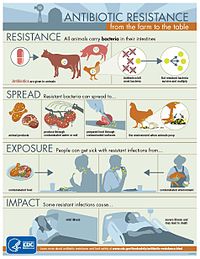
Photo from wikipedia
The increasing prevalence of antibiotic resistance among bacteria is one of the most intractable challenges in 21st‐century public health. Dipterans that associate with livestock, livestock waste products and cadavers have… Click to show full abstract
The increasing prevalence of antibiotic resistance among bacteria is one of the most intractable challenges in 21st‐century public health. Dipterans that associate with livestock, livestock waste products and cadavers have the potential to acquire livestock‐associated antibiotic‐resistant bacteria (LA‐ARB) and transmit them to humans. In this study, piglet cadavers were used to attract saprophage dipterans from the environment and those dipterans were sampled for the presence of LA‐ARB. In the first trial, culturable microbes resistant to both aminoglycoside and β‐lactam antibiotics were found in all cadavers and masses of dipteran larvae, and in three‐quarters of adult dipterans. In the second trial, over 130 culturable bacterial colonies resistant to β‐lactams were isolated from the cadavers, larval and adult dipterans. Over 100 of those colonies were coliform or metabolically similar bacteria. Adult dipterans carried β‐lactam resistant staphylococci, whereas those bacterial types were absent from larval dipterans and cadavers, suggesting they were picked up from elsewhere in the environment. This research indicates that LA‐ARB are ubiquitous in pig farms, and dipterans have the potential to carry medically important microbes. Further research is encouraged to determine the extent to which dipterans acquire microbes from animal agriculture relative to other environments.
Journal Title: Zoonoses and Public Health
Year Published: 2018
Link to full text (if available)
Share on Social Media: Sign Up to like & get
recommendations!